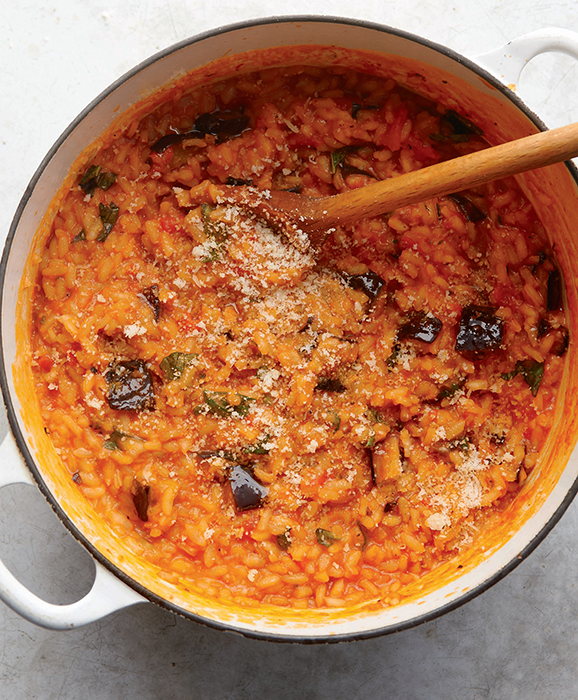MAKES 4 TO 5 SERVINGS
If you get a CSA basket you may receive lots of green garlic and favas in the spring (early spring if you live in California, later in more temperate climates). I can’t resist buying both when I go to the farmers’ market. Risotto is a perfect vehicle for these vegetables. The saffron makes this risotto all the more luxurious, both to the palate and to the eye.
Make the Arborio Risotto template with the following additional ingredients and specifications:
1 bulb green garlic, papery layers removed, minced
Generous pinch saffron threads
2½ pounds fava beans in the pods, shelled and skinned (see this page)
2 tablespoons chopped fresh parsley, tarragon, or chives, or a combination
- At the end of Step 2 of the template recipe, add the green garlic to the onion and cook, stirring, until fragrant, about a minute.
- Continue with Step 3, but just before you add the wine, rub the saffron between your thumb and fingers and stir into the rice. Stir in the wine and proceed with the recipe, adding the favas in Step 4 after the first 15 minutes of cooking and stirring the risotto.
- Finish the risotto, adding the herbs with the Parmesan and pepper with the last ladleful of stock.
ADVANCE PREPARATION: The favas can be skinned up to 2 days ahead of time. Keep in the refrigerator. For the risotto, see advance preparation notes in the template recipe.
VARIATION:
Add ½ pound asparagus, trimmed and cut into ¾-inch lengths, along with the fava beans and proceed as directed in the recipe.
How to Skin Fava Beans
Before you begin to shell (shuck) the favas, put a medium pot of water on the stove over high heat. By the time the water comes to a boil, you’ll have finished shucking the beans. Place the shucked beans in a bowl and fill another bowl with ice water.
When the water in the pot comes to a boil, add salt to taste and drop in the shelled fava beans. If the beans are about the size of your thumbnail or the first joint of your thumb, boil them for 2 minutes. If they are smaller than that, boil for 1 minute. Using a skimmer or a strainer, transfer the beans from the boiling water directly to the ice water. Allow them to cool for a minute or two in the ice water and drain. Don’t drain the boiling water until you’ve skinned a bean and ascertained whether or not it’s cooked enough for you. I like them just barely cooked through unless they’re very starchy, which is sometimes the case if the beans are large or beginning to dry out.
To slip off their skins, pinch off the eye of the skin, where it was joined to the pod, and gently squeeze out the bean. This will go more quickly if you hold several beans in one hand and use your other thumbnail and forefinger to pinch off the eyes, one after another, then squeeze the beans one after another right into a bowl or into your “pinching” hand.








